Landscaping in partnership with native ecosystems is good for the planet. It’s good for us too.
by Lillian Harris
Traditional landscaping is a process of carving out comfortable, orderly spaces where we can rest, play and express ourselves artistically, and even spiritually, through thoughtfully designed and maintained lawns and gardens. From the highly manicured English and Japanese-style gardens to the somewhat less orderly perennial gardens and expansive lawns of the Northeastern US, we can see the beauty and function these spaces provide.
Yet, a growing movement has been shifting the purpose of our landscaping toward a more inclusive objective. Instead of designing and maintaining human landscapes solely for recreation and beauty, what if our homes could be vital parts of the local ecosystem? Suburban and urban landscapes have an especially meaningful part to play in this as they are located in areas where natural processes have been more fragmented and disrupted by human habitation.
Allowing native plants to flourish is an essential ingredient in this effort. Non-native plants, including many popular landscaping plants, at their best have not evolved to provide the habitat and food needed by the insects and birds native to, and migrating through, our region. At their worst, some non-native plants become invasive and overwhelm local species, reducing biodiversity and overall ecosystem health.
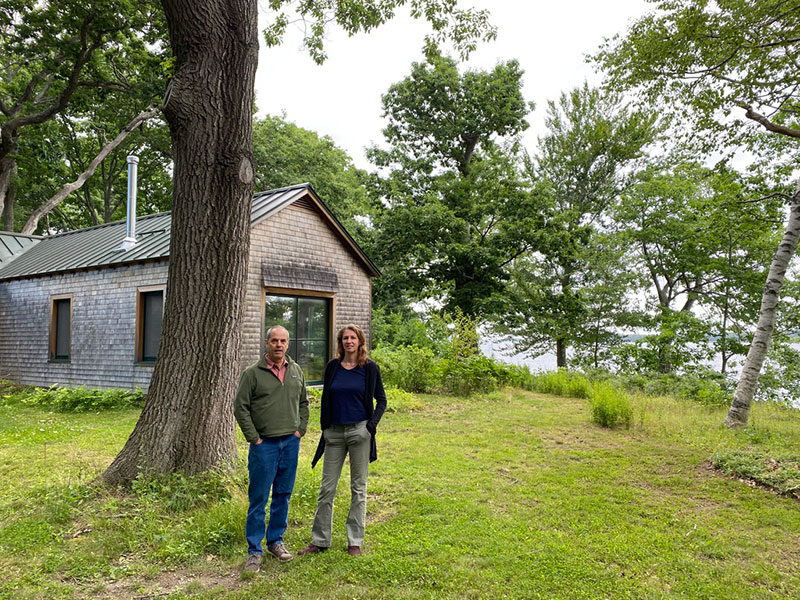
Lillian Harris and her husband Daniel Hildreth at their home in coastal Maine.
So what does native plant landscaping have to do without our mental health? At the same time as the natural environment is facing declining health due to a variety of factors, rising numbers of young people and adults are experiencing psychological distress as well. While there are many facets of our modern lives that contribute to poor mental health, I believe a big factor is living on a planet that we feel disconnected from, and that we know is also struggling.
Inspired by the work of Wild Seed Project, and others including Doug Tallamy’s Home Grown National Park, my husband and I have been shifting the landscape around our home from a traditionally landscaped property with large mown areas, tidy flowerbeds, and non-native trees, to a dynamic, evolving, celebration of native plants and all of the local fauna they support. As our partnership with the land has grown and expanded I have increasingly found joy in becoming more intimately connected with this life flourishing all around.
In reflecting on why this is, I have come up with some specific reasons why I believe landscaping in partnership with local ecosystems can help to heal not just native plant and animal communities, but also our mental health.
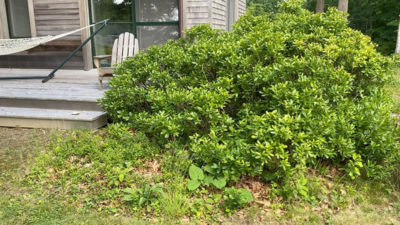
A fragrant northern bayberry next to Lillian’s home deck.
1. Deepen Belonging Partnering with the native ecosystem helps foster a sense of belonging. Belonging is a key factor of psychological well being. In psychotherapy we often focus on the importance of developing healthy, enduring relationships with other humans and our pets, but what about the relationships that are possible with all of the diverse forms of life around us? What about the kinship I feel with the quaking aspen who waves at me every time the wind blows, or with the chipmunk whose cheeks are bulging with the acorns I didn’t rake last fall? Disconnection and loneliness are at an all-time high in our communities. What if an antidote were right here at home, just waiting for us to take notice?
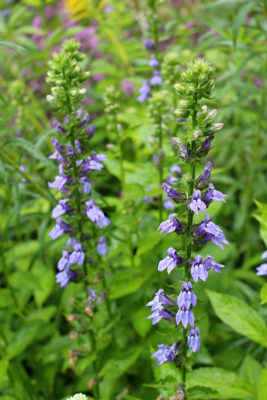
Blue lobelia
2. Reduce Perfectionism
We have a crisis of worthiness in our culture. We wonder if we’re smart enough, hard-working enough, pretty enough, strong enough, or if we have enough money. We compare ourselves to others, afraid we don’t measure up. Partnering with natural processes uproots the perfectionism that underlies lack of worthiness. As far as I can tell, the plants around my home don’t worry about being enough. They don’t grow in neat rows because that’s what is expected of them or to gain approval. One year I transplanted a blue lobelia to a carefully chosen place in the flower bed. The next year, this resourceful biennial did not continue growing where I planted it. Instead seedlings popped up in several new spots they chose for themselves. At first this was frustrating as my plans for the garden were overruled by a diminutive flower shedding its seeds. Over time I have learned to embrace the delightful surprise this plant gives me every year. Today this native perennial garden doesn’t have clean lines or tidy patches of color; everything is mixed together. It has a life of its own and it’s beautiful as it is. This is a great reminder that we too have the freedom to be ourselves, rough edges and all.
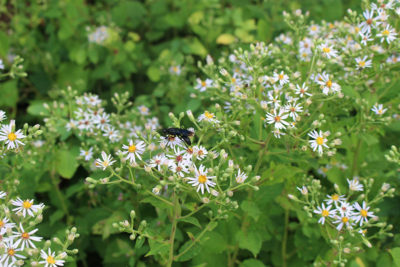
Large-leaved aster and pollinating wasp.
3. Learn to RelaxLandscaping in partnership with ecological processes helps us learn to relax and “trust the process.” At first adjusting your landscaping habits might not be relaxing! If you are used to tidy lawns and manicured flower beds, you may find a wild yard to be disorienting and even distressing. You might ask, “Who’s in charge here!?” Once you relax and let nature meet you halfway, you’ll find that you don’t have to DO so much and you can take more time to just BE. I planted a few hay-scented ferns in a bare area where a portion of the deck had been removed and they didn’t fill in as quickly as I hoped. I didn’t like that there was so much bare ground and fretted about what to do. Plant more? Plant something else? Wait until they fill in? In time, some flowering asters self-seeded and, just like that, my “problem” was solved. If I hadn’t waited to see what nature would do with the empty space, I wouldn’t have come upon such a simple, effortless solution. Now ask yourself, how often do you fret about a problem, turning it over in your mind, taking frantic action, just to find that in time it resolves itself making all of that angst unnecessary?
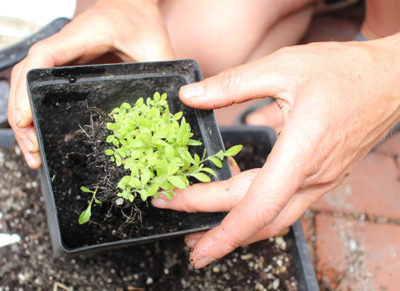
Growing native plants from seed is a way to participate in building back personal and ecological resilience.
4. Reciprocity Fosters a Sense of Purpose
It feels good to give back. There are so many ways that our daily lives involve harming the planet. I’m typing these words on a laptop made of mined precious metals and plastic and fueled by non-renewable sources of electricity. Even the most scrupulous among us take actions that harm the Earth when we are engaged with modern society. While we may dismiss this reality to go about our lives without constant inner turmoil and guilt, I believe it takes a toll. We don’t want to cause harm and yet we live in a world where it’s impossible not to. Partnering with nature in this way helps me feel that I am giving something back, that I am participating not just in the breaking down, but also in the rebuilding of the world around me.
One sunny fall day, as I cleared my vegetable garden in preparation for the coming winter, I noticed a small blooming goldenrod. I leaned over to pull it out, then paused. I looked around and saw that most of the goldenrods growing in the field surrounding my garden beds had gone to seed. It occurred to me that this flowering plant could provide a little more pollen and nectar to a passing bee so I left it. Sure enough, a few minutes later, a bumble bee buzzed by and landed on the yellow burst of color. My heart swelled knowing that I had contributed in a small way to the wellbeing of this generous pollinator, also preparing for the long winter ahead.
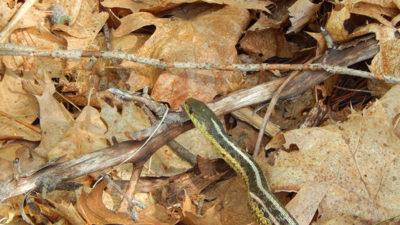
A garter snake thriving in fallen leaves and sticks.
5. Build Resilience
Meeting the challenges that come along with new ways of doing things builds resilience. There are aspects of partnering with the natural world that are not calming, soothing or restorative. Preventing a take-over by one (or many!) invasive species can make you feel like Sysiphus pushing his rock up a hill for eternity. Sometimes the seeds or seedlings you plant don’t want to grow there, or you find you really do have to mow part of your lawn to keep the ticks at bay. Rodents who delight in your untamed landscape may chew through wires or nest in car vents making you wonder if it’s all worth it. Ultimately, all of these challenges will be rewarded with thriving, vibrant wild spaces, right where you live, that nourish you and so much more life all around you.
Collaborating with your native landscape is an opportunity to cultivate strength, patience, fortitude, reciprocity, humility, purpose and belonging, all foundational qualities of good psychological health.

Bloodroot, foamflower and ostrich fern fiddleheads.
If you’re not convinced, give it a try. You may start out as a skeptic; I did. When I first looked at lists of native plants for landscaping, all I saw was what wasn’t there. No lilacs, poppies or peonies? No sweet-scented lily-of-the-valleys? I thought the garden would be boring and pale in comparison with what I was used to. I started experimenting with planting a few native plants, starting some wild seeds and letting what wanted to grow grow. Now I don’t see what I’m missing, only what is present, in abundance. I get excited for spring, not because of tulips and daffodils, but because of bloodroot, foamflower and fiddleheads. I anticipate bayberry leafing out and seeing where lobelia and butterfly milkweed will pop up this year. I look forward to welcoming the widening web of life that has grown to include all kinds of plants and animals, and also, that includes me.
A note from the author: This post was originally titled “Rewilding is Good for Our Mental Health” and was inspired by Wild Seed Project’s rewilding initiative. Upon learning of the deeply problematic and even harmful nature of this terminology from the staff at Wild Seed Project, I have rewritten it to reflect more inclusive and accurate language to describe landscaping with the intention of fostering ecological health to benefit and include both humans and the surrounding ecosystems. For more information on why the term rewiliding is no longer used by Wild Seed Project, refer to the statement at the conclusion of this article.
About the author: Wild Seed Project member Lillian Harris, LCPC, is a psychotherapist living on the coast of Maine. She has an undergraduate degree in Environmental Science and a masters degree in Mental Health Counseling and enjoys exploring where these disciplines intersect. She is the author of the Monhegan Nature Guide, a natural history and guide to hiking on one of Maine’s wildest offshore islands.

